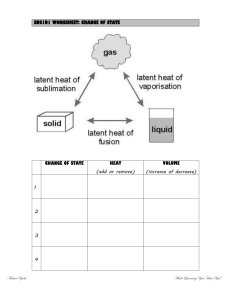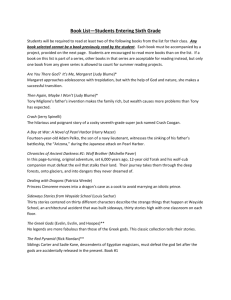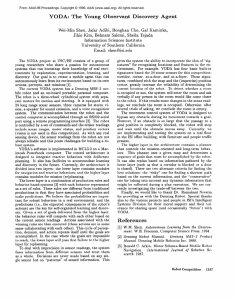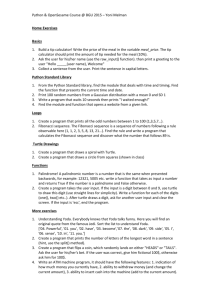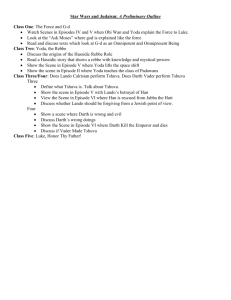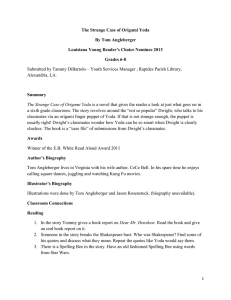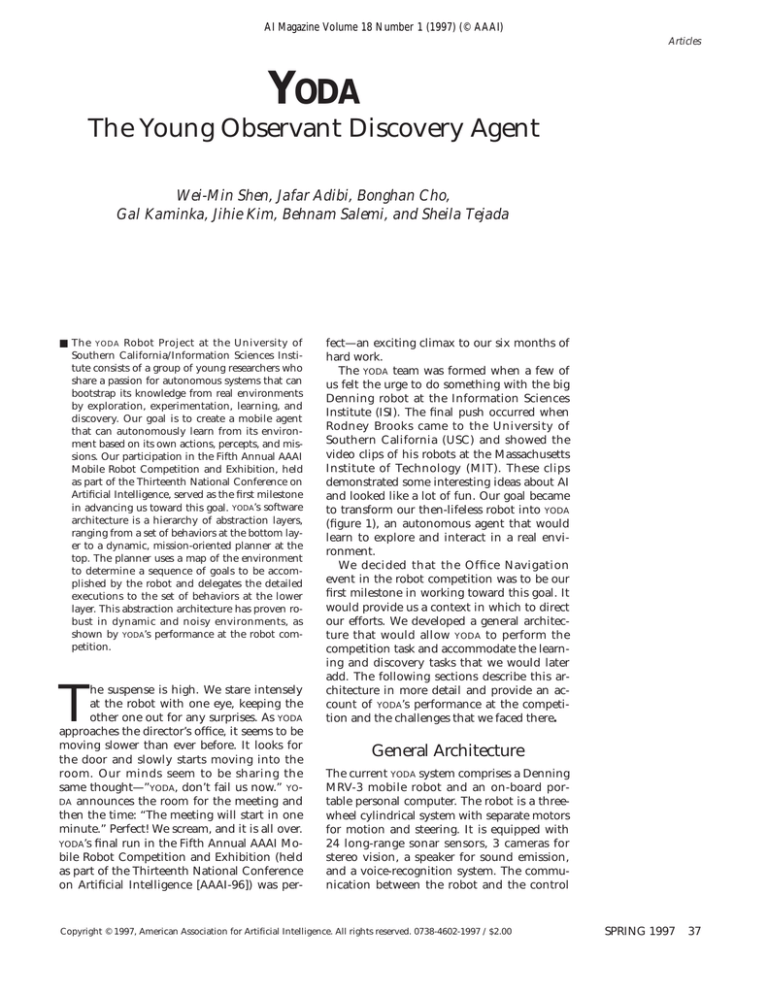
AI Magazine Volume 18 Number 1 (1997) (© AAAI)
Articles
YODA
The Young Observant Discovery Agent
Wei-Min Shen, Jafar Adibi, Bonghan Cho,
Gal Kaminka, Jihie Kim, Behnam Salemi, and Sheila Tejada
■ The YODA Robot Project at the University of
Southern California/Information Sciences Institute consists of a group of young researchers who
share a passion for autonomous systems that can
bootstrap its knowledge from real environments
by exploration, experimentation, learning, and
discovery. Our goal is to create a mobile agent
that can autonomously learn from its environment based on its own actions, percepts, and missions. Our participation in the Fifth Annual AAAI
Mobile Robot Competition and Exhibition, held
as part of the Thirteenth National Conference on
Artificial Intelligence, served as the first milestone
in advancing us toward this goal. YODA’s software
architecture is a hierarchy of abstraction layers,
ranging from a set of behaviors at the bottom layer to a dynamic, mission-oriented planner at the
top. The planner uses a map of the environment
to determine a sequence of goals to be accomplished by the robot and delegates the detailed
executions to the set of behaviors at the lower
layer. This abstraction architecture has proven robust in dynamic and noisy environments, as
shown by YODA’s performance at the robot competition.
T
he suspense is high. We stare intensely
at the robot with one eye, keeping the
other one out for any surprises. As YODA
approaches the director’s office, it seems to be
moving slower than ever before. It looks for
the door and slowly starts moving into the
room. Our minds seem to be sharing the
same thought—”YODA, don’t fail us now.” YODA announces the room for the meeting and
then the time: “The meeting will start in one
minute.” Perfect! We scream, and it is all over.
YODA’s final run in the Fifth Annual AAAI Mobile Robot Competition and Exhibition (held
as part of the Thirteenth National Conference
on Artificial Intelligence [AAAI-96]) was per-
fect—an exciting climax to our six months of
hard work.
The YODA team was formed when a few of
us felt the urge to do something with the big
Denning robot at the Information Sciences
Institute (ISI). The final push occurred when
Rodney Brooks came to the University of
Southern California (USC) and showed the
video clips of his robots at the Massachusetts
Institute of Technology (MIT). These clips
demonstrated some interesting ideas about AI
and looked like a lot of fun. Our goal became
to transform our then-lifeless robot into YODA
(figure 1), an autonomous agent that would
learn to explore and interact in a real environment.
We decided that the Office Navigation
event in the robot competition was to be our
first milestone in working toward this goal. It
would provide us a context in which to direct
our efforts. We developed a general architecture that would allow YODA to perform the
competition task and accommodate the learning and discovery tasks that we would later
add. The following sections describe this architecture in more detail and provide an account of YODA’s performance at the competition and the challenges that we faced there.
General Architecture
The current YODA system comprises a Denning
MRV-3 mobile robot and an on-board portable personal computer. The robot is a threewheel cylindrical system with separate motors
for motion and steering. It is equipped with
24 long-range sonar sensors, 3 cameras for
stereo vision, a speaker for sound emission,
and a voice-recognition system. The communication between the robot and the control
Copyright © 1997, American Association for Artificial Intelligence. All rights reserved. 0738-4602-1997 / $2.00
SPRING 1997
37
Articles
the shortest path between any pair of rooms
on the map. Because the empty conference
rooms are not known at the start, the robot
must have the capability of finding the shortest path to each conference room until an
empty room is found, then plan the shortest
route between the professor and director
rooms. At the middle layer of the architecture, each shortest path found by the planner
is expressed as a sequence of behavioral actions with appropriately assigned parameters.
YODA’s four generic behaviors are (1) passing
through a doorway, (2) traveling to a landmark, (3) audio communicating, and (4) detecting an empty room. Each of these behaviors is implemented at the bottom layer of
the architecture in terms of the basic actions
(forward, backward, and turn) and perceptions (sonar vectors, x-y locations, and angles).
Notice that the main idea behind this architecture is abstraction, with each layer being an abstraction of the layer that is immediately below. The top layer, as shown in figure
2, only reasons about the relationships between rooms; so, when YODA starts out at the
director’s room, the dynamic planner decides
which conference room to visit first. The
landmark planner expands the high-level
plan by determining the route between
rooms in terms of landmarks, such as doorways, hallways, and corners. Once the route
has been planned, then the behavior controller is called to move the robot safely from
landmark to landmark. This configuration
was a large contribution to the building of a
robust performance system, as demonstrated
by YODA’s success in the competition.
Figure 1. YODA Wandering the Halls of the
Information Sciences Institute.
computer is accomplished through an RS232
serial port using a remote programming interface (Denning 1989). The robot is controlled
by a set of commands, and the sensor readings include sonar ranges, motor status, and
position vectors (vision was not used in this
competition). As with any real sensing device,
the sensor readings from the robot are not always reliable, which poses challenges for
building a robust system.
YODA’s software is implemented in MCL2.0
on a MACINTOSH POWERBOOK computer. The
control architecture (figure 2) consists of
three layers and is designed to integrate deliberate planning with reactive behaviors. The
top layer is a dynamic planner that can find
38
AI MAGAZINE
Dynamic Planner
On the top layer of the architecture, the dynamic planner determines all the mission-oriented long-term behaviors of the robot. For
the Office Navigation event, there are two
mission-oriented behaviors or goals: (1) find
an empty room and (2) notify the professors
of the meeting time and place. To accomplish
these goals, the planner must find the shortest path between a set of rooms as well as determine the necessary actions to interact with
the environment. The planner needs to be
dynamic because it must decide the current
plan based on information that it is acquiring
from the environment. For example, when
trying to find the empty conference room,
YODA needs to move from its current room to
the nearest conference room and then detect
if the room is empty. If it is occupied, then
the robot moves to the nearest unchecked
Articles
Dynamic room planner
D
C
P
D
Landmark / node planner
door Hallway Corner door
Behavior Controller
findDoor
passDoor
2walls 1wall foyer
sound …
Figure 2. The Three Abstraction Layers of YODA’s Control Architecture.
conference room. However, if the room is
empty, then the current plan is to satisfy the
next goal of finding the shortest route to notify the professors.
The current plan is determined using the
information acquired from the environment
in conjunction with a set of tables that provide the shortest-path information corresponding to the current situation. These tables are built from parsing the input map.
The input map (figure 3) consists of a list of
records, one record for each location or node.
A record contains the node type (corridor,
room, foyer), adjacent nodes, and the distances to adjacent nodes. The planner builds
three tables by parsing this map. It first computes the shortest paths among the conference and professor rooms based on the connections and distances of the nodes. These
paths are stored in a table called the path
table. Each path consists of a list of nodes and
the length of the path. Once the path table is
created, the system then builds the notify
table by computing the shortest route to visit
the professors’ rooms. The notify table consists of a list of all the nodes in the route and
the route length. It can be used to notify the
professors given the empty conference room.
Finally, the scenario table is built based on
these two tables.
A scenario is a permutation of the set of
conference rooms. Each scenario denotes the
order in which the conference rooms are visited. For example, given three conference
rooms, C1, C2, and C3, one of the permutations is (C1, C2, C3), meaning that C1 is visited first, then C2, then C3. The scenario table
records the total route lengths for the different possibilities of empty conference rooms
for each scenario. For this example scenario,
the planner computes the total route lengths
for three cases: (1) the total route length for
visiting C1 first and then the professors’
rooms, assuming C1 is empty; (2) the total
route length for visiting C1 first, then C2,
and then the professors’ rooms, assuming C1
is occupied, and C2 is empty; and, finally, (3)
the total route length for visiting C1 first,
then C2, then C3, and then the professors’
rooms, assuming C1 and C2 are occupied,
and C3 is empty. These three route lengths
are stored in the table with the scenario. The
number of cases depends on the number of
conference rooms.
SPRING 1997 39
Articles
C1
C2
C3
C4
C7
R6
R7
C8
C5
R1
C6
R2
((setq *conference-rooms* '(R4 R2))
(setq *professor-rooms* '(R1 R8))
(setq *director-room* 'R5)
(setq *starting-room* 'R5)
)
Prof. 1
C9
R9
R8
C10
Conf. 1
C12
C13
Director
R5
C11
R3
Conf. 2
C14
F1
C15
Foyer
C16
R4
C17
(setq *map*
‘((C1 C (C2 E 100) (C7 S 100))
(C2 C (C1W 100) (R6 S 0) (C3 E 100))
(C3 C (C4 E 100) (R7 S 0) (C2 W 100))
(C4 C (C8 S 100) (C3 W 100) (C5 E 200)
(C5 C (C4 W 200) (C6 E 160) (R2 S 0))
(C6 C (C5 W 160) (C11 S 230))
(C7 C (C1 N 100) (C9 S 160) (R6 E 0))
...........
)
Prof. 2
Figure 3. An Example of the Input Map.
Given the scenario table, there are at least
three ways to select one of the scenarios: We
can select the scenario with the minimum total route length when the first conference
room is empty. In the given example, the system will select the first scenario shown in
figure 4. The second strategy selects the scenario that has the minimum total route
length for the case where only the last conference room in the sequence is empty. In the
given example, this strategy will select the
third scenario. The third strategy is to select
the scenario with an average minimum,
which is the second scenario in the example.
We used the first strategy to select a scenario
for the competition. By building the tables
from bottom to top (from path table to scenario table), we not only avoid redundant
computations in the future (during execution) but also save recomputations while we
build the tables.
Landmark Planner
At the middle layer of the architecture, the
landmark planner reasons about each plan
found by the high-level planner in terms of
behavioral actions. This layer also controls
the execution of the high-level plan and the
time-estimation task involved in notifying
the professors. Once a scenario is selected, the
scenario is executed as travel through a sequence of conference rooms. When a confer-
40
AI MAGAZINE
ence room is found empty, the plan execution is based on a sequence of professors’
rooms that were already planned as the shortest path. The room-to-room traveling, in
turn, is executed as travel through a sequence
of nodes in the room-to-room path.
There are various types of navigation between two nodes. The landmark planner expands the high-level plan into a set of lowlevel navigation behaviors depending on the
types of the two nodes. For example, “passing
through the doorway” is the navigation type
necessary to connect from a hallway type to a
room type and “recognizing a landmark” to
connect from a hallway type to a hallway
type (or foyer). Although most low-level behaviors are specified at this level of the execution hierarchy, some behaviors, such as “detecting an empty room,” have already been
specified in the high-level plan.
This hierarchical plan execution enables
the plan to be safely recovered in case of a
crash. The plan can be executed from the
point of the crash instead of the beginning.
The hierarchical execution keeps the current
status hierarchically (for example, the current
room, the current node) so that the point of
the execution at the time of the crash can
easily be located in the whole sequence of
the overall plan.
Our time estimation is based on the time
data recorded during the plan execution. YO-
Articles
uses the time data from its past activities
(from the beginning of a competition run to
the point where the estimation is needed for
notifying the professors). The key idea for accurate estimation is the use of multiple types
of time data. The collected time data are organized by the various types of robot behavior
(for example, “recognizing a landmark,”
“passing though a doorway”) and used for estimating the execution time for each type occurring in the future plan. A default value is
used for unavailable data. The estimation
might require interpolation or averaging
techniques to adapt the data for parameterized behaviors. For example, the data for the
behavior of recognizing a landmark includes
a distance and a time. When we have more
than two data items for recognizing a landmark, we calculate an average speed.
DA
Behavior Controller
This subsection describes the design rationale
and implementation of each behavioral action. They are, in many ways, similar to the
behavior-based systems reported in Arkin
(1987). Each behavior in itself is an independent program module that transitions the
robot from one state to a desired state in a
way that is as robust as we can achieve. To
deal with imprecision in sensor readings,
each behavior abstracts only the necessary
perception information from the raw readings. The ability to focus attention and ignore
those irrelevant sensor readings contributes
greatly to the robustness of these behaviors.
Passing through a Doorway The basic
idea behind the behavior of passing through
a doorway is symmetry. When in the vicinity
of a doorway, this behavior computes the
sum of the sonar readings on both sides of
the robot when heading toward the doorway.
These sums are then compared to each other.
If they are roughly equal to each other, then
the robot concludes that it is at the center of
the doorway, and it moves forward for a distance and computes the symmetry values
again. Of course, at the same time, it also
checks if the front sonar readings are sufficiently large so that there is indeed room to
move forward. If the sum on one side is
sufficiently larger than the other, then the
robot first turns 45 degrees toward the side
that has a larger sum and then forward for a
short distance before doing another symmetry computation. What made this approach
work was to dynamically determine how
many sensors on each side to sum and what
the threshold is for being symmetric. One
heuristic we use is as follows: When the robot
1. (C1,C2,C3): (100,150,190)
2. (C3,C1,C2): (110,140,170)
3. (C2,C1,C3): (130,140,160)
Figure 4. An Example of a Scenario Table.
is far from the doorway, pay more attention
to the sonars that are at the front. As the
robot moves closer to the door, pay more attention to the sonars that are at the sides,
and the threshold for symmetry should be
lower.
The symmetry idea works well even if the
door width is very narrow compared to the
size of YODA. As a cylinder of 90 centimeters
(cm) in diameter, YODA has used this idea to
successfully pass many doors 100 cm wide.
This approach, of course, must rely on the
fact that sonar readings from the walls adjacent to the door are reliable. At the competition, because most of the walls were made of
painted cardboard boxes, the sonar beams
that hit the walls at about a 45-degree angle
were mostly bounced away; so, YODA could
not see the walls and believed that it was going in a good direction. To compensate for
this uncertainty, we used another strategy
that ignored these unreliable readings and focused only on the direction where the door
is. This strategy is not as precise as the symmetry idea, but it is good enough to pass
doors that have a larger width. (Doors at the
competition were 110 cm wide).
Another challenge is to know when you
have actually passed out the doorway. The
problem is that in some cases, the walls for
the doorway are thin; so, when the robot
passes the door, the sonars are not able to detect them. YODA uses the information stored
in the map about the distance needed to pass
out the room into the hallway. Once YODA has
traveled the necessary distance, it assumes
that it has passed the doorway, even though
it did not detect it.
Traveling to a Landmark
This behavior
is designed to guide the robot from one location to another along a certain path. One
problem is that the locations of the starting
and the ending positions are only known to a
certain extent because a large amount of er-
SPRING 1997 41
Articles
YODA
YODA
A
Figure 5. A Signature is the Known Sensing Pattern for a Situation.
A. An example of a signature for recognizing a doorway from a hallway.
B. A signature for recognizing a hallway.
rors can be accumulated from the previous
actions that YODA has performed. Another
problem is that there also might be obstacles
along the path, whether they are static furniture or people who just walk by. The challenge is keeping the robot on the right path
(such as a hallway) and at the same time
avoiding obstacles. To overcome the uncertainty of goal location, we used the idea of
finding a goal landmark as a way to detect
whether the goal position has been reached
or not. For example, if the goal position is a
corner of a hallway, YODA uses the open space
on the appropriate side as the landmark. If
the goal position is at a door, then YODA actually looks for the door when the location to
the goal position nears.
To navigate through certain terrain (such
as a hallway or a foyer), we developed an idea
called a signature. A signature is the known
sensing pattern for a situation, and it is to be
matched to the current sensor readings to determine the current position and orientation
as well as find the best direction to go. For example, the signature for a hallway in term of
the 24 sonar readings is a vector, such that
the readings parallel to the hallway are large
(figure 5a), but the readings against walls are
small (figure 5b).
A signature has an orientation and can be
rotated to match a given sonar vector. Thus,
42
AI MAGAZINE
when YODA is in a hallway, it can rotate the
hallway signature to find the best matching
direction against the current sonar readings
(figure 6). This direction will indicate the best
direction to move to keep parallel with the
walls. We call this “finding the best direction,” and it is performed when the robot
finds itself too close to the walls or obstacles.
To detect obstacles, YODA always keeps an
eye on the direction it is moving. It has a virtual cushion space. This space is adjusted relative to its speed and orientation. For example, it has a large cushion in the direction it is
moving, and it is even larger when the speed
is high. If an obstacle is detected within this
space in the moving direction, YODA stops immediately and then tries to find the best direction there. If an obstacle is detected in the
cushion space but not directly in the moving
direction, YODA concludes it is unsafe. It first
slows down and then adjusts its direction according to the current signature.
The signature idea works well when the
robot is following one wall (figure 5a) or two
walls (figure 5b). However, there are no walls
at a foyer, which caused problems for the signature approach. Strictly applying the signature can give you a direction that is not the
best for reaching the goal, and the signature
of foyer does not contribute much because all
directions look the same. To overcome this
problem, we used the idea of virtual path. Before YODA starts a movement from one place
to the other, it first computes a path between
the two places. Although this path can only
be an estimation because of the sensor errors,
whenever YODA finds itself in a position where
there is no wall nearby, it tries to keep on the
path as long as there are no obstacles. If some
obstacles have forced YODA to deviate from
the path, it detects the deviation and tries to
come back to the path before moving any
further. This way, we have a reliable way to
recover from any deviation. At the competition, there were several occasions when this
behavior saved YODA from becoming lost in
the environment. YODA’s movement control
system is designed to bypass any obstacle or
people during its movement toward a goal.
However, if an obstacle is so large that the
passage to a goal position is completely
blocked, the robot stops and asks politely for
people to move away.
For the compeAudio Communicating
tition task, YODA needed to inform each of the
professors of the time and place for the
scheduled meeting as well as possibly interact
with people who might be obstructing its
path. Also, YODA was required to communi-
Articles
cate with the audience as much as possible,
so that the audience could better understand
the reasoning behind YODA’s actions. YODA’s
voice is a collection of recorded phrases made
by all the team members. This feature gives
YODA a unique character.
Audio communication was also a helpful
tool for debugging purposes. For example,
when testing the passing through a doorway
behavior, we noticed that if the walls of the
doorway were thin, YODA would not say that
it had passed the doorway, even though it
was already in the middle of the hall. Thus,
we concluded that YODA could not detect the
thin doorways properly; so, we altered the behavior, as mentioned previously.
Detecting an Empty Room We use only
the front sonars to detect whether a conference room is empty. Once YODA enters a
room, it keeps computing the degree of
changes in the sonar values. If the degree is
greater than the given threshold, YODA considers the room not empty. Any movement of
the occupants in the room, including vertical
movement (walking toward YODA) or horizontal movement (walking side to side), is effective for this detection.
Although any movement of the occupants
is effective for detection, to make YODA’s behavior more pleasant and natural, we used a
special strategy for the competition. We put a
bowl of M&M candy on top of YODA and
asked people in the room to come get some
candy. This strategy ensured that if the room
were occupied, someone in the room would
move toward YODA, and the sonars would detect the movement. We assumed that everyone in the competition could be tempted by
M&Ms, and they did indeed.
The Competition
More than 20 teams—all with different backgrounds, robots, and approaches but with
one unique aim to advance mobile robot
technology—competed in the 1996 robot
competition. Team YODA entered the exhibition hall two days before the competition.
We have to admit we were not optimistic
when we first arrived at the huge hall where
all the teams were unloading their robots and
setting up their equipment. At first, YODA had
a serious hardware problem: It refused to boot
up. After fixing the hardware problem, YODA
was ready to test in the competition environment, and it took some time for YODA to adjust to the new environment.
The competition was conducted in three
rounds: (1) preliminary, (2) semifinal, and (3)
YODA
Figure 6. The Signature for Recognizing a Hallway Shown in Figure 5b Has
Been Rotated to Correspond with the Current Situation.
final. Although YODA had been tested in many
different environments at USC/ISI, we soon
discovered that YODA had problems operating
in this new environment. The sonars did not
work well because of the special materials
used for the walls. The emitted sonar signal
was bouncing away; so, YODA could not detect
the walls at certain angles. This signal problem caused YODA difficulty when entering
conference rooms and passing through the
foyer. For the preliminary round, we solved
this problem by covering the appropriate
walls with a different material (YODA T-shirts).
We also realized that YODA was too conservative in its time estimation. YODA would add
about two minutes in anticipation of possible
obstacles on its return route to the director’s
office. However, the distribution of obstacles
was much lower than previously expected.
To ready YODA for the semifinal, we spent
the next 24 hours fixing these problems by
changing several parts of code. We changed
YODA’s passing-through-a-doorway strategy as
described earlier and used a more conservative approach to avoid hitting the side walls.
Moreover, we eliminated the two-minute
margin so that YODA can more accurately calculate its time estimation of the task. In the
semifinal round, YODA performed perfectly
and had no points deducted. YODA was ready
for the final round.
During the final round, actor Alan Alda
was filming for the PBS television program
Scientific American Frontiers, which made us
even more nervous. However, we enjoyed seeing Alan Alda interact with YODA. When YODA
was checking to see if a conference room was
empty, it was Alan Alda who walked up to YODA and took some M&Ms. The audience was
also pleased with the use of different voices.
You could never guess what voice YODA would
use next. The rest of the story is history. YODA
SPRING 1997 43
Articles
performed the task perfectly and ended in the
director’s room, stating, “The meeting will
start in one minute.” Despite the fact that YODA was the biggest, heaviest, and oldest robot
in the competition, a band of amateurs,
working nights and weekends, was able to
shape a lifeless robot into YODA, a robust autonomous agent. For the YODA team members,
this feat was truly surprising and an extremely exciting experience.
Related Work
YODA’s abstraction architecture originates from
a prediction-based architecture called LIVE
(Shen 1991; Shen and Simon 1989) for integrating learning, planning, and action in autonomous learning from the environment
(Shen 1994). It also bears many similarities to
Erann Gat’s (1992) ATLANTIS architecture,
which integrates planning and reacting in a
three-layer, heterogeneous asynchronous architecture for mobile robots. Different from
ATLANTIS , however, YODA uses a closed-loop
control theory (Goodwin and Sin 1984), as
well as the idea of a signature, to maintain the
awareness of its current states and control its
low-level behaviors. Furthermore, YODA also
uses landmarks to initiate and terminate the
execution of sequences at the middle layer.
The use of signatures is closely related to
Arkin’s (1987) behavior-based approach and
schema theories by Arbib (1981) and others.
Our motivation for using declarative representations is to facilitate our long-term goals
for learning models from the environment
and collaborations among multiple heterogeneous agents. In this aspect, YODA seems to
have a different philosophy about models of
the world than Brooks’s (1991, 1986) subsumption architecture.
Acknowledgments
We would like to thank Ramakant Nevatia for
providing us the Denning Robot. Special
thanks to the various projects and people in
the ISI Intelligent Systems Division for their
moral support and their tolerance for sharing
space (and occasionally “forces”) with YODA.
References
Arbib, M. 1981. Perceptual Structures and Distributed Motor Control. In Handbook of Physiology—The
Nervous System, II, ed. V. B. Brooks, 1449–1465.
Bethesda, Md.: American Physiological Society.
Arkin, R. C. 1987. Motor Schema-Based Mobile
Robot Navigation. International Journal of Robotics
Research 8(4): 92–112.
Brooks, R. A. 1991. Intelligence without Represen-
44
AI MAGAZINE
tation. Artificial Intelligence 47(2): 139–160.
Brooks, R. A. 1986. A Robust Layered Control System for a Mobile Robot. IEEE Journal on Robotics
and Automation 2(1): 14–23.
Denning. 1989. Denning MRV-3 Product Manual.
Denning Mobile Robotics Inc., Wilmington, Massachusetts.
Gat, E. 1992. Integrating Planning and Reacting in
a Heterogeneous Asynchronous Architecture for
Controlling Real-World Mobile Robots. In Proceedings of the Tenth National Conference on Artificial
Intelligence, 809–815. Menlo Park, Calif.: American
Association for Artificial Intelligence.
Goodwin, G. C., and Sin, K. S. 1984. Adaptive Filtering, Prediction, and Control. New York: Prentice Hall.
Shen, W. M. 1994. Autonomous Learning from the
Environment. New York: W. H. Freeman.
Shen, W. M. 1991. LIVE: An Architecture for Autonomous Learning from the Environment. ACM
SIGART Bulletin (Special Issue on Integrated Cognitive Architectures) 2(4): 151–155.
Shen, W. M., and Simon, H. A. 1989. Rule Creation
and Rule Learning through Environmental Exploration. In Proceedings of the Eleventh International Joint Conference on Artificial Intelligence,
675–680. Menlo Park, Calif.: International Joint
Conferences on Artificial Intelligence.
Wei-Min Shen is a research assistant professor in the Computer
Science Department at the University of Southern California
(USC) and a senior research scientist at the USC/Information Sciences Institute. He received his
Ph.D. in computer science from
Carnegie Mellon University in
1989 on the subject of autonomous learning. From
1989 to 1994, he was with the Microelectronic and
Computer Technology Corporation, where he
spent five years applying innovative research results to solving industrial problems. His current research interests include machine learning and discovery, autonomous agents and robots, intelligent
information integration, and data mining. He has
an international reputation in these research areas
and has authored one book and about 45 technical
papers in journals and conferences.
Jafar Adibi is a Ph.D. student in
the Department of Computer Science at the University of Southern California (USC). He recived
his B.S. in electrical engineering
from Isfahan University of Technology, Isfahan, Iran, and his
M.S. from USC. Currently, he is a
graduate research assistant at the
USC/Information Sciences Institute, where his current research interests include soft computing
methods, knowledge discovery, and applications of
AI in medicine.
Articles
Bonghan Cho is a Ph.D. candidate in the Department of Computer Science at the University of
Southern California (USC). He received his M.S. from USC in 1989
and his B.S. from the Department
of Computer Science and Statistics, Seoul National University,
Korea, in 1987. He is currently
working for the SOAR Project. His areas of interest
include constraint-satisfaction problems, the scaling up of knowledge base systems, and computer
networks.
Gal Kaminka is a graduate research assistant at the Information Sciences Institute, University
of Southern California (USC),
and a Ph.D. student in the Computer Science Department at
USC. He completed his undergraduate education in computer
science at the Open University of
Israel. His interests are in the areas of agent modeling, agents that reason about themselves, failure
and anomaly detection, and fuzzy set theory.
Jihie Kim is a computer scientist
in the Information Sciences Institute at the University of Southern
California (USC). She received her
Ph.D. in computer science from
USC in 1996 and her M.S. and B.S.
in computer science from Seoul
National University in 1990 and
1988, respectively. Her research
interests include machine learning, intelligent
agents, rule-based systems, knowledge-based systems
for information retrieval, and electronic commerce.
Behnam Salemi is a graduate
student in the Department of
Computer Science at the University of Southern California and a
graduate research assistant at the
Information Sciences Institute.
He received his B.S. in computer
science from Shahid-Beheshti
University, Tehran, Iran, in 1991.
His research interests include autonomous learning
and intelligent agents in the domains of robotics
and education.
Sheila Tejada is a Ph.D. student
in the Department of Computer
Science at the University of
Southern California and a graduate research assistant at the Information Sciences Institute. In
1993, she received her B.S. in
computer science from the University of California at Los Angeles. Her research interests include machine learning, planning, intelligent agents, and data mining.
Start Your Planning Library
With These New Volumes from
AAAI Press
Advanced Planning Technology:
Technological Achievements of the
ARPA/Rome Laboratory Planning Initiative
Edited by Austin Tate
This volume presents the range of technological results that have
been achieved with the ARPA/Rome Laboratory Planning Initiative. Five lead articles introduce the program and its structure
and explain how the more mature results of individual projects
are transferred through technology integration experiments to
fielded applications. The main body of this volume comprises
one paper from each group or project within ARPI. Each of these
papers seek to introduce the technological contribution of the
group’s work and provide a pointer to other work of that group.
ISBN 0-929280-98-9 282 pp., index, $55.00 softcover
Proceedings of the Third
International Conference on
Artificial Intelligence Planning Systems
Edited by Brian Drabble
The 1996 proceedings have tried to bring together a diverse
group of researchers representing the various aspects and threads
of the planning community.
As with all previous AIPS conferences, the papers have been selected on technical merit. They include practical algorithms for
achieving efficiency in planning, formal results on the completeness and complexity of planning domains, classical planning, formal specification of planning knowledge and domains, constraint-satisfaction techniques and their application, reactive
planning, and repair and consistency checking in schedules.
ISBN 0-929280-97-0 292 pp., index, $55.00 softcover
Order from The AAAI Press
445 Burgess Drive, Menlo Park, CA 94025
(415) 328-3123
(415) 321-4457 (fax)
orders@aaai.org
http://www.aaai.org/Press/
SPRING 1997 45
Insert IOS Press AD
46
AI MAGAZINE

